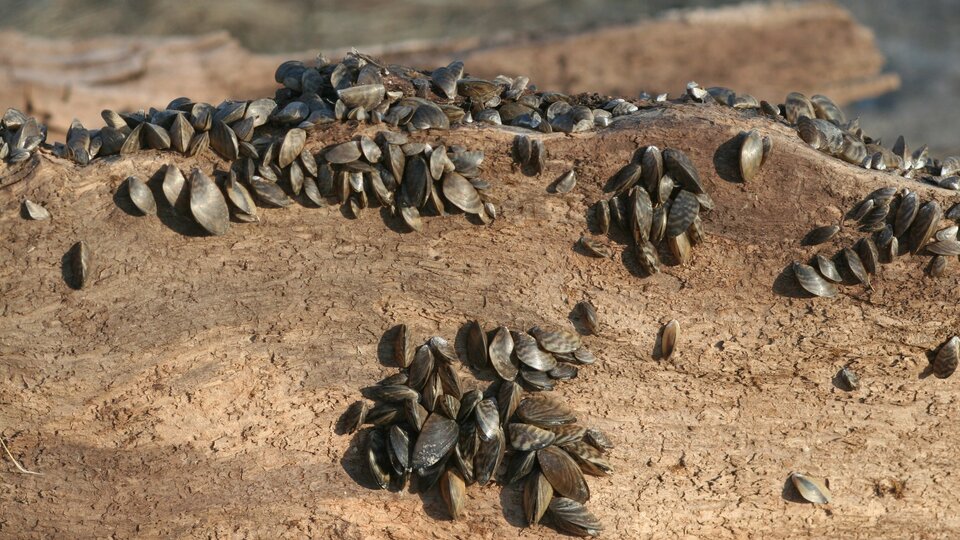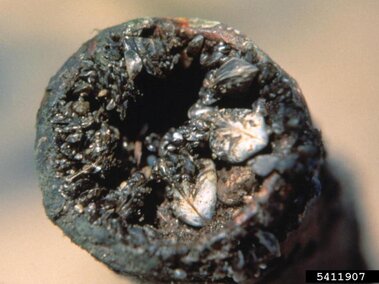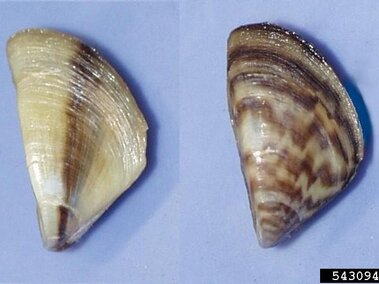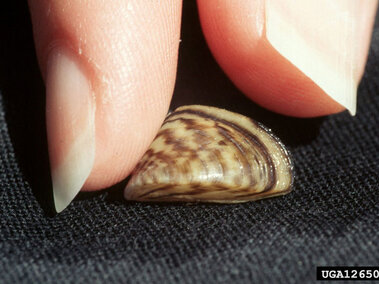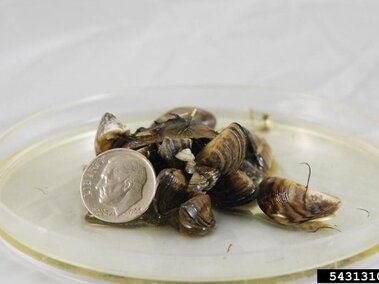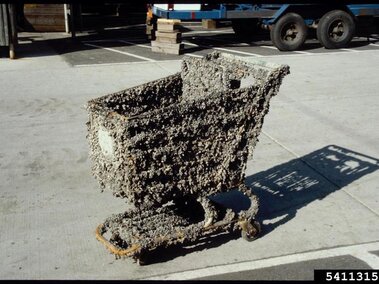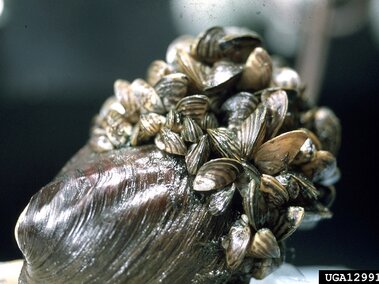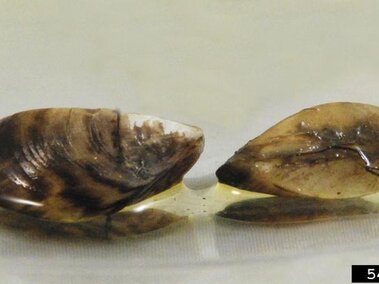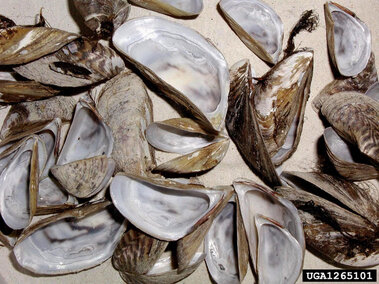General Information
Species Name: Dreissena polymorpha
Also Known As: No other names
Family: Dreissenidae (False Mussel)
Life Span: 2-5 years
Life Cycle: Zebra mussels are extremely prolific breeders, which contributes to their ability to spread rapidly and abundantly. An adult female zebra mussel can produce about 30,000–40,000 eggs each reproductive cycle and upwards of 1 million each year. Free-swimming microscopic larvae, called veligers, will drift in the water for several weeks and then settle onto any hard surface they can find.
Origin: Europe (Black, Caspian, and Azov Seas)
Injurious: Yes. Currently under the Lacey Act, zebra mussels are listed as injurious wildlife by the U.S. Fish and Wildlife Service, which prohibits the importation into or transportation between the continental United States, the District of Columbia, Hawaii, the Commonwealth of Puerto Rico or any territory or possession of the United States of live zebra mussels, gametes, viable eggs and hybrids.
Category 2: Priority Aquatic Invasive Species
Why Are They Invasive?
Zebra mussels are efficient filter-feeders, removing much needed phytoplankton from the water column that native species need to survive. They also can tolerate a wide range of environmental conditions and adults can even survive out of water for about 7 days. Unlike other freshwater bivalves, zebra mussels are able to attach to surfaces using their byssal threads and form large clusters similar to oyster beds. It is not uncommon to find populations with densities of over 100,000 individuals per square meter, with some reaching up to 1 million per square meter. These clusters destroy private property and public infrastructure, and also clog irrigation pipes. Additionally, they are hazardous to beach-goers and swimmers who can cut themselves on their sharp shells.
What Do They Look Like?
Zebra mussels are named for their dark and light stripes across their shell. Adult sizes can range from 1/2” to 2” long, but usually grow to be no larger than your pinky nail. The shell has “D” shape, with one flat edge and one curved edge. Juvenile mussels are microscopic and cannot be see with the naked eye.
Photos
Where Do They Live?
Zebra mussels can grow in a variety of environments, including Nebraska’s freshwater systems. They can establish in still or moving water systems. Currently, zebra mussels are established in five waterbodies in Nebraska: Missouri River, Lewis and Clark Lake, Lake Yankton, Offutt Air Force Base Lake, and Beaver Lake in Plattsmouth.
How Do They Spread?
Zebra mussels are primarily spread via recreational boating and fishing. Adult mussels will adhere to equipment and the underside of watercraft, “hitchhiking” unbeknownst to the equipment owner. Larval stage zebra mussels, which are microscopic and cannot be seen with the naked eye, can survive in small amounts of water for up to 30 days, and can accidentally be introduced by taking water from one waterbody to another.
Zebra mussels were initially introduced to North America via ballast tank discharge from cargo ships that had entered the Great Lakes region after departing from zebra mussel’s native range in Europe. Since their North American introduction in the 1980s, they have spread throughout most of the Eastern United States.
How Do I Control Them?
Contact the Nebraska Game and Parks Commission to determine appropriate control methods. Unfortunately, eradication of a zebra mussel population once established in a waterbody is nearly impossible. To prevent their spread and introduction into your waterbodies:
CLEAN your watercraft, trailer, angling gear and other equipment. Remove all aquatic vegetation and animal species from your equipment.
DRAIN your watercraft at the ramp by removing the boat plug and draining all live wells and ballast tanks.
DRY your watercraft, trailer and other equipment for at least 7 days before visiting another waterbody.
DON'T DUMP BAIT. Dispose of bait by emptying bait buckets on dry land, away from waterbodies or in a trash receptacle. Moving a live organism from one waterbody to another is illegal, even if you are planning to use the organism as bait.
DON'T LET IT LOOSE. Do not release or transport exotic or non-native fish species to new ecosystems. It is unlawful to release any aquatic species into a waterbody other than the one from which it was harvested. Doing so can promote the spread of AIS.
What Should I Do If I See Them in Nebraska?
If you see zebra mussels in Nebraska, you should report them to the Nebraska Game and Parks Commission's Aquatic Invasive Species (AIS) Program using their AIS Report Form. For guidance on what information to include in your report, check out our reporting tips.
References and More Information
Center for Invasive Species and Ecosystem Health
Global Invasive Species Database
Illinois Department of Natural Resources
Lemmens, P., Laverty, C., Lucy, F. E., & Dick, J. T. A. (2022). What we know and don’t know about the invasive zebra (Dreissena polymorpha) and quagga (Dreissena rostriformis bugensis) mussels. Hydrobiologia, 849, 2747–2764. https://doi.org/10.1007/s10750-022-04950-5
Minnesota Department of Natural Resources
Nebraska Game and Parks Commission
New Hampshire Department of Environmental Services
Non-Native Invasive Species Secretariat
North Caroline Wildlife Resources Commission
Oklahoma Department of Wildlife Conservation
Smithsonian Environmental Research Center
Summary of Species Currently Listed as Injurious Wildlife under (18 U.S.C. 42) Lacey Act
US Geological Survey Nonindigenous Aquatic Species
